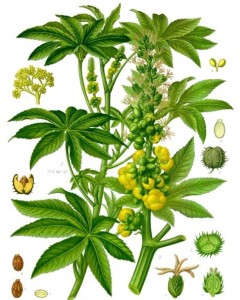— This article by Jerry Cates was first published on 23 October 2015, and revised last on 12 September 2016. © Budsinthenews Vol. 6:10(9).
Ricinus communis is variously known as the castorbean or castor-oil-plant, and is a flowering plant in the spurge family, Euphorbiaceae. The genus Ricinus and the subtribe Ricininae are both monotypic, as they contain only the single species Ricinus communis. Reproduction is via a mixed pollination system.
That system favors self-pollination by geitonogamy, i.e., pollination of one of its flowers via pollen that drifts from a neighboring flower on the same plant. However, pollination also takes place via outcrossing, by either of the two processes described below. Outcrossing is the practice of introducing unrelated genetic material, from other plant species, into a breeding line. The process increases genetic diversity, which reduces the probability of an individual being subject to disease, while reducing the risk of genetic abnormalities common to strict inbreeding pollination systems.
The first of the outcrossing processes used by R. communis is known as anemophily, which uses wind-blown pollen from unrelated plant species to pollinate its flowers. The second process, entomophily, uses pollen distributed by insects.
The seed of the castor oil plant is known as a castor bean. Despite that name, it is not a true bean. The castor oil plant is native to the southeastern Mediterranean Basin, Eastern Africa, and India. Today it is widespread throughout earth’s tropical regions and is widely grown as an ornamental plant in subtropical and temperate regions as well.
Taxonomy:
- Domain: Eukaryota (yew-carr-ee-OH-tah) — from the Greek prefix ευ (yew) = good, well, pleasing + καρυον (khar-yone) = a nut/nucleus, thus organisms whose cells contain a nucleus and other organelles within membranes.
- (unranked): Bikonta Cavalier-Smith, 1993 (bye-KOHN-tuh) — from the Latin bis = twice/double + the Greek κοντος = a punting pole; those eukaryotic organisms within the subgroups Apusozoa, Rhizaria, Excavata, Archaeplastida, or Chromalveolata.
- (unranked): Archaeplastida Adl et al., 2005 (ahr-kee-PLASS-tih-duh) — from the Greek αρχαιος (AHR-kee-ose) = ancient/antiquated + πλασις (PLAS-iss) = a moulding + Anglo Saxon tid = time; a major group of eukaryotes, comprised of the red algae (Rhodophyta), the green algae, and the land plants along with the freshwater unicellular algae known as glaucophytes.
- Kingdom/Regnum: Plantae Copeland, 1956 (PLAN-tee) or Viridiplantae Cavalier-Smith, 1881 (veer-id-eye-PLAN-tee) — from the Latin planta = a green twig; the plant kingdom, consisting of multi-cellular green plants, i.e., whose cells have cellulose within their cell walls and have primary chloroplasts derived from endosymbiosis with cyanobacteria containing chlorophylls a and b and lack phycobilins..
- (unranked): Streptophyta Jeffrey 1967 (strepp-toh-PHY-tuh) — from στρεπτος (STREP-tose) = (easily) twisted, pliant + φυτον (PHU-tawn) = a plant/tree; the land plants and the green algal group Charophyta.
- Subkingdom: Embryophyta Engler, 1892 (imm-bree-oh-FYE-tuh) — from the Greek εμβρυον (EMM-bree-yon) + φυτον (PHU-tawn) = a plant/tree; green plants, informally known as land plants because most are terrestrial rather than aquatic, while the related green algae are primarily aquatic;
- (unranked): Angiosperms (AN-gee-oh-spurms)/Magnoliophyta Cronquist (mag-NOH-lee-oh-fye-tuh) — from the Greek αγγειον (AUGG-ee-awn) = a vessel/pail/reservoir + σπερμα (SPUR-mah) = a seed; the flowering plants, distinguished from the gymnosperms by having flowers, endosperm within the seeds, and the production of fruits that contain the seeds;
- (unranked): Eudicots (YEW-dee-kotts) — from the Greek prefix ευ (yew) = good, well, pleasing + δι (die/dee) = two/double + κοτυληδων (cott-ee-LEE-dun) = a cup-shaped hollow; a monophyletic clade of flowering plants previously known as tricolpates or non-magnoliid dicots, to emphasize the evolutionary divergence of tricolpat dicots from earlier, less specialized dicots; close relationships are presumed among flowering plants with tricolpate pollen grains (the grains have three colpi, or elongated apertures or furrows in the pollen grain paralleling the polar axis);
- (unranked): Rosids — a large monophyletic clade of flowering plants comprised of some 70,000 species;
- Order: Malpighiales Juss. ex Bercht. & J. Presl (mahl-peg-ee-AWL-ees) — named by the French botanist Charles Plumier, in honor of Marcello Malpighi’s work on plants; this is a large order of flowering plants comprising 16,000 species of diverse plants in 32 to 42 families;
- Family: Euphorbiaceae Juss. (yew-fohr-bee-ACE-uh-ee) — the spurge family, a large family of flowering plants in about 300 genera and 7,500 species; most of these species are herbs. but some are trees or shrubs;
- Subfamily: Acalyphoideae (ey-callie-FOY-duh-ee) — a subfamily of the Euphorbiaceae comprised of 21 tribes;
- Tribe: Acalypheae Dumort., 1829 (ey-callie-FAY-ee) — a tribe of the subfamily Acalyphoideae, comprised of 12 subtribes and 32 genera;
- Subtribe: Ricininae (reh-SINN-enn-ee)
- Genus: Ricinus L. (REH-seh-nuss) — a genus in the subtribe Ricininae, comprising a single species, R. communis;
- Species: R. communis (kuh-MUNE-iss) — from the Latin word Ricinus = tick, for the resemblance of the seeds in color and shape to certain ticks; this is a fast growing, suckering, non-cold-hardy perennial shrub that an reach the size of a small tree, with glossy long, long-stalked alternate and palmate leaves, flowers that are borne in terminal panicle-like inflorescences without petals, and a spiny capsule tearing large, oval, shiny bean-like and highly poisonous seeds with brown mottling;
References: In process… we do not post references that are not in our at-hand library and that we have not thoroughly examined. The vetting process takes time. A list of appropriate references relevant to the matter presented in this article will be posted as it becomes available.
—Feel free to e-mail jerry.cates@entomobiotics.com regarding your comments on this article. You may also register, log in, and leave a detailed comment in the space provided below.
